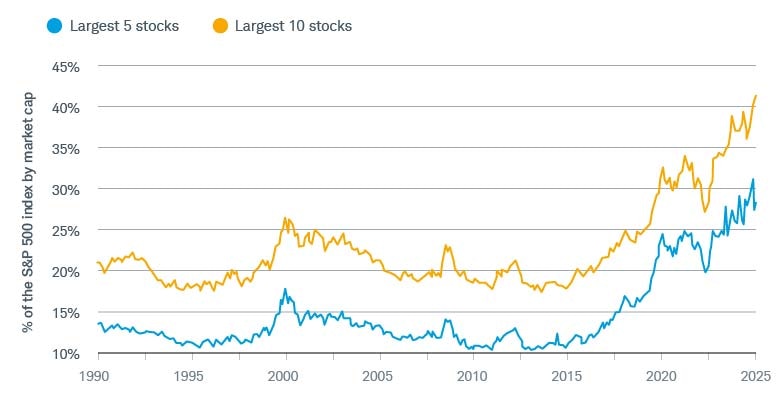3 Ways to Navigate Mega-Cap Concentration Risks

Within the S&P 500® index, mega-cap concentration risks have risen sharply over the past decade. Although this has enhanced returns for many investors, it's important to remember that concentration risk is a double-edged sword that can potentially cut both ways. This may be especially worth keeping in mind given today's frequently shifting economic and investment landscape. So, if your portfolio has become too heavily concentrated in a handful of high-flying stocks, now may be the right time to take some chips off the table, rebalance, and add a bit more diversity to your investment holdings or retirement nest egg.
Record-breaking concentration risks in perspective

Sources: Schwab Center for Financial Research®; Bloomberg.
Monthly data for the 35 years ended 09/30/25. Indexes are unmanaged, do not incur management fees, costs, and expenses and cannot be invested in directly. For more information on indexes, please see schwab.com/indexdefinitions. Past performance is no guarantee of future results.
As the chart above illustrates, stocks of the largest 10 firms in the S&P 500 index accounted for approximately 40% of the index's total market capitalization at the end of September. Not only is this the biggest concentration in more than 35 years, it's a larger chunk of the total market cap of the index than during the run-up to the dot-com bubble, or even when the bubble finally burst in March 2000. If you reduce the number of largest stocks from 10 down to 5, the total market capitalization is still more than 25%.1
This concentration shouldn't come as a complete surprise, given that market cap-weighted index strategies tend to place bigger premiums on the performances of their largest stocks. In turn, this translates into weightings that generate outsized performance effects. For a deeper dive into this topic, here's a related article: Limitations of Stock Indexes & How to Use Them.
The only free lunch in investing
The good news, for the moment at least, is that there's still time to diversify. As the late American economist and Nobel Laureate Harry Markowitz, Ph.D.—a pioneer of modern portfolio theory, or MPT—has been credited with saying, diversification is the only free lunch in investing. And for investors who think that their portfolio is probably overdue for a concentration risk tune-up, diversification and rebalancing opportunities seem to be more plentiful than ever. What follows are three strategies that might make sense to consider if your portfolio seems like it's overexposed to mega-caps.
Opportunity #1: Explore Fundamental Index® strategies
One approach to achieving greater portfolio diversification could be to complement your traditional cap-weighted index funds with Fundamental Index strategies. These strategies weight companies based on "fundamentals," using measures like cash flow, dividends, and revenue. By breaking the link between stock price and index weight, the Fundamental Index method results in industry weights that reflect a company's economic footprint.
This means that Fundamental Index strategies can work alongside market cap-weighted index strategies, potentially offering better overall diversification when the two are used together. Plus, Fundamental Index strategies are available in both mutual funds and exchange-traded funds (ETFs), giving you an opportunity to select your investment vehicle of choice. If you'd like to learn more about these strategies, here's a link to a podcast that provides a detailed discussion about Fundamental Indexing: Beyond Market Cap: Fundamental Indexing Explained (with Rob Arnott).
Looking for a Fundamental Index fund?
Explore ETFs at Schwab.
Opportunity #2: Consider equal-weighted index strategies
A second option might be to pair your market cap-weighted index funds with equal-weighted index strategies. This may be one of the easiest ways to improve your overall diversification. Keep in mind though that sector weights within an equal-weighted index can sometimes seem a bit arbitrary. That's partly because the number of stocks in these indexes usually matters more than the size of the underlying companies themselves. Trading costs can also be a bit higher than in a cap-weighted fund or Fundamental Index strategy, particularly for less liquid parts of the market like small-cap stocks and emerging markets. So, there are definitely some caveats to keep in mind.
Opportunity #3: Get help from a professional
Seeking professional help is a third possibility. At Schwab, we offer wealth and investment management solutions designed to fit a wide range of client needs, financial situations, and investing styles. These include full-service wealth management solutions provided by a dedicated advisor, managed portfolios with specific investment goals, automated solutions with professional help when needed, and even comprehensive and personalized wealth management strategies that start with your goals and adapt to your changing needs.
Looking for professional help from Schwab?
Explore some of our solutions.
Bottom line
Today's financial landscape is complex. Between sticky inflation and the slowing U.S. jobs market, the clouded outlook for economic growth and interest rates, and the tariff-related see-saw, there's a lot to consider. Added to this list is that mega-cap concentration risks in the S&P 500 index have reached their highest levels in more than 35 years. So, if your portfolio or retirement nest egg might need a concentration risk tune-up or may not be properly prepared for what's ahead, consider exploring some of the opportunities we've just talked about.
1Schwab Center for Financial Research, "Every Brea(d)th You Take: Market Concentration Risks," published 9/15/25; accessed 10/06/25: https://www.schwab.com/learn/story/every-breadth-you-take-market-concentration-risks.
Cash flow for a company can be measured by its statement of cash flows, which reflects a company's financial activity over a period of time and shows where its cash comes from and how the cash is used to pay for operations and/or invested.